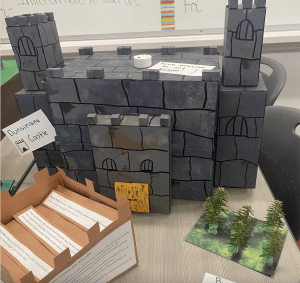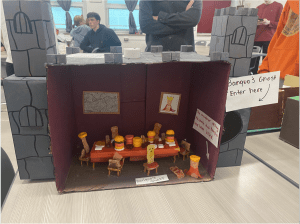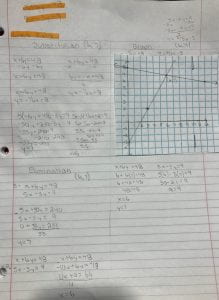For this project, we were tasked with creating a structure, like a gingerbread house, displaying an important structure from a book. My partner and I decided to use Macbeth as our inspiration. Together, we built Dunsinane Castle, with scenes from the play included in the house, like a dollhouse. We built the scene with the feast and Banquo’s ghost out of pretzels and sourpatch kids. We included the outside environment by building Birnam Wood out of sourpatch kids and sprigs from a Christmas tree.
Projectile Motion Inquiry Task
Personal Challenge: Prior to lab, choosing the proper UAM equation and how to derive for certain variables was confusing, especially in two-dimensional motion. During the completion of the lab, I was required to choose a UAM equation and derive for the variables of velocity and time. Additionally, the task was on two-dimensional motion, which required me to understand the concepts of free-fall and horizontal velocity in the same problem. Additionally, the task required me to understand how to derive for variables using horizontal and vertical land.
Personal Growth: The lab made the concepts of free-fall and two-dimensional motion clearer by requiring me to use UAM equations to derive an equation to solve for a specific unknown. Additionally, the lab required me to write a lab report, which enlightened me in the necessary information required for a lab report and how to explain the steps for the deriving and collecting of data. Finally, the made it clearer how to design an experiment to solve a variable by collecting data and deriving an expression.
AP Research Reflection Post: Part 2
Name two strategies you used during the class that helped you manage your time and complete a task/goal on time. How did this help you stay on track or create a well-put-together section of the paper? Name two scenarios where you could have improved your time management or sought help for an issue you were facing. How will you learn from this and apply it to another class/scenario in the future?
In the beginning of the school year, I tried using a planner to organize my thoughts and plan out my schedule. This was quickly phased out as I never kept up with using the planner and relied on my memory to get assignments done on time. The biggest strategy I used to stay ahead with my project was to follow his due dates and not attempt to extend them. By following his guidelines and due dates I was able to complete my project without too much rush. I’m not the best at time management and actually procrastinate quite a bit, however I was able to complete all of the assignments on time. If I ever felt bored, I would use the time to analyze my data or sort through responses. When it came time to put together my paper, all of my sections had been completed by the time I got to spring break and it didn’t take too much effort to revise.
Like I mentioned earlier, my time management is not great. I decided to wait until after the ACT to start collecting my data, which was fine because I was still ahead for my project. The only issue was that I procrastinated going to stores and gathering data and didn’t have it finished until late March. This put me a little behind, but I was able to catch up again. I sought help after collecting my data on how to write my analysis. I truly did not understand what to put in the analysis or how to structure it. I asked my English teacher for her input. I did this once again when putting together my presentation. I was stressed about the order of the slides and the overall information that should be included.
This class has really taught me that I need to get better at managing my time and not procrastinating. While I would like to be able to keep a planner, I don’t think that it’d be the best option for me because I’d forget to update it or even look at it. Perhaps I should try sticking notes to my computer to help me remember what I need to complete. The aspect of time management is really necessary in all pf my classes considering that I am taking mostly APs and play sports. Additionally, I need to get better at asking questions and asking for help. It’s not that I don’t want help, but I can’t think of any questions to ask. Overall, I need to get better at managing my time and asking others for help.
AP Research Reflection Post: Part 1
Reflect on one challenge you encountered in developing your topic or research question. What is one thing you would change about picking a topic/collecting data? How would the strategy you discussed help improve your project?
When I first started AP Research, I had no idea what my topic should be or what would make a good topic. Originally, I wanted to do a scientific experiment or do a project related to the Pink Tax and was stuck in limbo on which topic would make a better research project. The biggest challenge for me was deciding how to make the project “good” and I focused too much on the score aspect of the class rather than the actual research process. I am unsure of how ended up deciding on a topic but I did eventually land on the Pink Tax. While this topic was interesting, I found that it was difficult to acquire some sources since it was a topic that was not often studied.
Throughout the course of the class, I often compared myself to others and theirs projects and I found that was the biggest barrier to me being confident in my topic and completing a solid project. I wondered if I had picked a topic that was rigorous and required effort or if my project was “too easy”. With so many people telling me that surveys don’t score well, I felt dejected. Others in my class were completing experiments and conducting full-scale interviews, and to me it felt as though my project was inferior. But after completing the year, I’ve come to realize that comparing my project to others did not nothing to help me. I focused more on the score I would get rather than actually writing my paper.
Looking back on the year, if I were to give myself one piece of advice , it’d be to stop focusing so much on what other people are doing and to focus on what you want to do, and how you want to structure your project. It’ll be much more worthwhile if you are confident in your abilities while writing this paper, whether it be in actual topic selection or your chosen method. I’m glad I never switched my topic as I think I had interesting results. If I had listened to my thoughts in the middle of the year and switched, I think I would’ve felt even more dejected.
Cinnamon Roll Stoichiometry
I made a cinnamon roll recipe and used stoichiometry conversions to discover how much of each ingredient I needed to make one “mole” or one cinnamon roll. The presentation below shows all of my steps.
Clinometer Project
Finding the measurements of items using the angle measure found by a clinometer
- What was challenging about this activity. Explain?
- Measuring the distance from the object and making sure the clinometer was working correctly were difficult because they can mess up the entire measurement.
- What might explain why some groups have different answers for the same object?
- Differences in the angle measure as well as errors in the measurement of the distance from the ground may have caused differences
- What types of professions do you think might use indirect measurement?
- Professions that deal with the measurement of large or far objects, like an architect or engineer.
- Explain the steps needed to measure the height of a tree using a clinometer.
- First, it’s necessary to have a working clinometer. Then, you want pick a spot which you want to measure from and measure the distance from you to the tree. After that is complete, you should use the clinometer to look at the highest point of the tree and find the angle of elevation. After to finding these two measurement, you can solve for the height. After using tan of the angle, times the distance measurement to find part of the height of the tree, you have to add your height (minus a couple of inches to account for eye placement) to find the final height of the tree.
Parabola Selfie Project
In this project, I found an everyday object with a parabola shape and created a equation for that parabola.
https://docs.google.com/presentation/d/1srC9k9lFvuVfM7knlGNfCeUTh0M3jfjbpVaeMAC-N48/edit?usp=sharing
Systems of Equations
Give a brief description of the project. Describe what you were supposed to do.
In this project, we were given a system of equations to solve by substitution, elimination, and graphing for the purpose of comparing the methods. My work for each method is shown in four boxes each depicting a different method and my solution.
Which method did you think was the easiest to use? Why?
The elimination method was the easiest for me to complete given this particular set of equations. It took less time and was easier to understand compared to the other methods.
Which method was the most difficult for you? Why?
The graphing method was the most difficult for me because it took the longest out of all of the methods.
What did you notice about the solution of the system, regardless of the method used?
Regardless of the method used, the solution of the system was always (6,7).
Genetic Counselor
For this project, we were tasked with choosing a case on a genetic disorder and providing information as a genetic counselor. We were to help the case family make a decision on whether they should have children and wrote a letter to the family. I chose to a help a family with a history of thalassemia. By creating a Punnett square and pedigree chart, I was able to explain the pattern of inheritance to the family. The letter applies to the communicate skill through our explaining and helping of the family. Below is my letter.
Letter to Clients
June 9th, 2020
Mr. and Mrs. Andino
Dear Mr. John Andino and Mrs. Sophia Andino:
I am writing to you as a Genetic Counselor reviewing your case. My name is Livia Kola and I am providing information on thalassemia as it pertains to your situation.
Thalassemia is an inherited blood disorder that affects hemoglobin production in the body, leading to fewer red blood cells. This disease can be categorized in minor, intermedia, or major forms depending on the severity. Mutations of the HBB or HBA1 and HBA2 gene cause beta or alpha thalassemia, respectively. The disease can cause fatigue, slow growth, and weakness along with abdominal swelling and bone deformities. Those with severe cases receive blood transfusions often and have a normal life expectancy, but complications may make the disease fatal before the age of thirty.
Upon reading your case, I have discovered that both of you are carriers for the thalassemia trait but display no symptoms. Being carriers for the disease means that both of you have a heterozygous genotype. Additionally, Sophia has a family history with the disease along with a brother that is affected by a major form of the disease. This is important in determining the likelihood that your children will be affected.
Constructing a Punnett Square to show inheritance allows us to see the probability that your children will be affected. Because thalassemia is autosomal recessive, your children would need a homozygous recessive genotype to be affected. Additionally, thalassemia is not sex-linked, meaning that it is just as likely to affect a male as it is a female. After studying the Punnett Square for your case, I can see that your children have a 25% chance to be affected, 50% chance to be carriers, and 25% chance to be completely unaffected.
| T | t | |
| T | TT | Tt |
| t | Tt | tt |
Having children in your situation is a risk and will likely result in many sacrifices that need to be made. However, people with thalassemia can live an incredibly full and happy life regardless of any health complications. It’s clear that you want a baby, and I would recommend trying for your first child. Remember, however, if your child is born with a major form of thalassemia, they will need large amounts of medical attention through blood transfusions, iron regulation, and sometimes removal of swollen abdominal organs.
Fortunately, some options test for diseases before birth. One is prenatal testing or chorionic villus sampling. In this test, sample cells are taken from the placenta and tested for genetic diseases. This can be done as early as ten weeks into the pregnancy. Depending on the results, you can choose to terminate the pregnancy. Another option is preimplantation genetic diagnosis done through in vitro fertilization. Eggs and sperm are combined outside the body to form an embryo which can then be tested for genetic disorders. The embryos that are free of genetic problems can be implanted into the uterus. Both these methods are expensive, however, and may not be suitable options for your family. If your child is born with a severe case of thalassemia, a stem-cell or bone marrow transplant may be an option, but it is difficult to find a suitable donor.
Know the risks and accept the sacrifices. Remember that your child can live a perfectly happy life, regardless of the disease.
Sincerely,
Livia Kola, MS
Certified Genetic Counselor
1212 Fake St, Rubber Duck, Ohio
Astrobiology Background Information
For this project, we were tasked with obtaining information on careers in astrobiology. After taking a few career quizzes, we chose a career to relate to astrobiology. I chose a biochemist. We then created a resume for a job at an astrobiology company and included made up education and career experience. We also created a cover letter for the job. Both are below.




